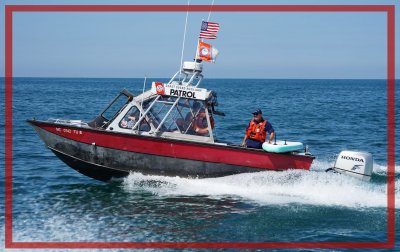| TOP | Archives |
|
SUBSCRIBE: Atom RSS What’s This? |
 |
Congress honored the U.S. Coast Guard Auxiliary with a proclamation read by Rep. Nick LaLota recognizing the significant and enduring contributions of Auxiliarists across the nation. Lieutenant Chris Booth from the Office of the Chief Director of Auxiliary at Coast Guard Headquarters described the proclamation as, “Truly unforgettable recognition that serves as a fitting tribute to the selfless volunteerism continuously exhibited by Auxiliarists as they educate America’s recreational boating public and augment important Coast Guard missions.” This special acknowledgment highlights the unwavering dedication and impact of our volunteers supporting Team Coast Guard.
Link to the full video can be seen here: https://www.youtube.com/watch?v=0kaE-rB1O9U
 |
6 ways Auxiliarists can support their local units
By John Saran, AUXPA1, District Captain East, Auxiliary Ninth Western Region (CG District 9)
John Saran is an active member of the Coast Guard Auxiliary. Here are his suggestions on how best to integrate Auxiliary members with operational active duty units. These suggestions will also be presented during an Auxiliary segment at the 2024 Sector Lake Michigan CO/OIC Conference.
Below are the top six general pathways that Auxiliarists should explore to support local boat stations:
Search and Rescue (SAR) & Training Support – Trained and qualified Auxiliary crews (coxswains and crewmembers) can provide additional SAR and training support for local boat stations. For example, Chicago Division 35 provided such support in July 2023 for Coast Guard Station Chicago. Over the course of two weeks, Auxiliary crews spent over two hundred hours conducting patrols and being on SAR standy, resulting in the prosecution of numerous SAR cases. Careful planning of patrols can ensure that Auxiliary operational time is optimized for lifesaving missions.
Auxiliary boat and air crews can also provide training support to local boat stations, whether it’s providing boat facilities for two-boat training, conducting AUXAIR fixed-wing aircraft operations or engaging in formal SAR exercises. For example, this past summer, on Lake Michigan in the Ninth District, there were three SAR-related training exercises involving several units. Coverage of the first event at Coast Guard Station Michigan City can be found here. The second event occurred on the same weekend in early June at Coast Guard Station Charlevoix in the Traverse City, Michigan area involving Team Coast Guard personnel (including Ninth Central Auxiliarists) and four members of the Canadian Coast Guard Auxiliary. The final event occurred at Coast Guard Station St. Joseph and Coast Guard Station Michigan City in September and involved active duty, reserve and Auxiliary (Ninth Western Region) crews from three states that manned six surface facilities and one AUXAIR aircraft.
Watchstanding – As stations might rotate personnel and prioritize active duty watchstanding capabilities for certain SAR and other lifesaving missions, there may be opportunities for Auxiliarists to fill in as watchstanders. Not only would this provide greater coverage for active duty operations, but also help ensure that Auxiliary operations occur.
Culinary Assistance – Small boat stations with galleys may have culinary specialist personnel gaps that Auxiliary culinary assistants could fill. Qualified members could help maintain station morale by supporting the culinary mission and provide liberty and/or training time for active duty culinary specialists. In the Ninth District, Auxiliary culinary assistants cooked meals during SAR exercises at Coast Guard Station Michigan City and Coast Guard Station St. Joseph, provided galley coverage at Coast Guard Station Grand Haven during the Coast Guard Festival so that personnel could engage in training and hosted a chili cookoff at Coast Guard Station Chicago.
Seasonal Station Smalls – Since crews at all seasonal station smalls will be transferred to their parent commands, there could be opportunities for the Auxiliary to have a presence at such seasonal stations. Such presence could range from holding meetings, public education events, fellowship events, open houses and other activities to utilizing such stations for Auxiliary patrols. A good example of this occurred in the Ninth District, where nearly 50 Auxiliarists, led by the District Staff Officer for Operations, District Captain and local AUC, supported the active duty personnel in keeping Station (Small) Wilmette Harbor operational. This Auxiliary team provided 18 patrols that supplemented the active duty’s coverage and held events at the station to maintain a presence.
Public Affairs – Many stations engage in public affairs activities, whether it’s hosting open houses, participating in community events or maintaining an active social media presence. Use of social media is important now more than ever. Auxiliarists can assist stations in covering the accomplishments of their shipmates to assist in retention, showcasing Coast Guard missions as a recruiting tool and providing important information to the public. However, public affairs and social media manager duties are collateral to other duties around the station for personnel. Accordingly, stations could look to qualified Auxiliarists to support their station’s public affairs mission.
Fellowship – Many shipmates at small boat stations might be facing life-changing transitions, such as transferring to other units and re-located across the country. Auxiliarists can tap into their life experiences and provide fellowship support to these individuals as they navigate these changes. An informal cookoff event, as an example, might help provide a temporary reprieve and a taste of home for station personnel.
Auxiliary Unit Coordinators (AUC) should seek guidance from their active duty and reserve unit commands. While boat station needs will inevitably vary across the country, unit commanders and Auxiliary leadership should consider these opportunities for Auxiliary support.
-USCG-
Published in MYCG at 6 ways Auxiliarists can support their local units > United States Coast Guard > My Coast Guard News (uscg.mil)
Kelly L. Townsend, DIR-B has recently been appointed as one of the Coast Guard Auxiliary's three representatives to the Governing Board of the United Safe Boating Institute (USBI). He is joining the current USBI President, Capt. William S. Griswold, USCG Ret. and COMO Warren E. McAdams, Past ANACO-RBS. Mr. Townsend replaces Past ANACO Charles (Tony) Morris, who is stepping down after a two year term on the board.
Congratulations Kelly!
Source [Terry Barth, N-EA]
Our Fall 2014 issue of Waves has now been posted to the RBS Outreach website. There are a host of RBS related articles, including; The induction of Dan Maxim into the Boating Safety Hall of Fame, A Paddle Ready app from the American Canoe Assn, New lifejacket labeling and designs, Strategic Partnerships with the States, and an article on "Why We're Here". Click on this link to see the full version of the WAVES Newsletter for Fall 2014.
Source [Bob Myers, DIR-Bd]
Our Spring 2014 issue of Waves has now been posted to the RBS Outreach website. There are a host of RBS related articles, including; We honor the United States Power Squadron (USPS) as it celebrates its 100th birthday, Meet the new Director of the National Safe Boating Council, The rescue of a kayaker in Michigan, Iinformation from the 18th Annual International Boating & Water Safety Summit, Cover news and updates on Marine Dealer Visits, Highlights from the US Coast Guard Auxiliary report on the national meeting of the United States Power Squadron (USPS) and Discussion of an On-the-Water Boat Training Simulator.
Click on this link to see the full version of the WAVES Newsletter for Spring 2014.
The latest issue of Waves, the RBS Outreach watercraft and vessel safety newsletter, has now been posted. There's an article on suggested newspaper stories which your flotilla can modify for publicizing RBS activities, another on the VSC Data Collection Project as well as a number of other articles which we feel you will find interesting.
Source [Bruce Lindsey, DVC-BE]
The Recreational Boating Safety Outreach Directorate is pleased to present the current issue of WAVES, Watercraft and Vessel Safety newsletter. We hope that you enjoy the information on USCG Auxiliary boating safety activities, and find the boating and water safety information helpful. The printable PDF is here.
With this issue we also introduce our newly appointed WAVES editor, Branch Chief for newsletters, BC-BRN William Carter from Flotilla 12-8 in Charleston, SC. William is currently Vessel Examiner and Program Visitor qualified. We welcome William to the RBS Outreach staff, and hope that you enjoy the newsletter.
Source [Robert P Myers, DIR-Bd]
The RBS Outreach Directorate is pleased to announce a new partnership with Orion Signals, a leading manufacturer of flares and other emergency signaling devices. Orion is offering Auxiliarists a free "Safety Awareness Kit".
Source [Bob Myers DIR-Bd]
The latest issue of Waves, the RBS Outreach watercraft and vessel safety newsletter, has now been posted. Check it out for suggestions for making your upcoming NSBW activities more rewarding and effective Read it here.
Source [Robert P. Myers Deputy Director (Dir-Bd)]
The latest issue of Waves, the RBS Outreach watercraft and vessel safety newsletter, has now been posted. It is chock full of stories of interest to everyone involved in the mission of recreational boating safety. Read it here.
Source [Robert P. Myers Deputy Director (Dir-Bd)]
This RBS Alert Notice is to clarify the role of the US Coast Guard Auxiliary and US Power Squadrons Vessel Examiners (VEs). Please download the PDF file from the link below and pass it on to all VEs that you know.
http://safetyseal.net/pdf_files/Clarification-of-VE-Role.pdf
Source: [Kelly Townsend, DIR-V]
The 2012 edition of the Coast Guard Auxiliary Grants Handbook is now available. The Grants Handbook includes information about several awards and grants available to Auxiliarists and Auxiliary units.
Demand for the Coast Guard publication, A Boater’s Guide to the Federal Requirements for Recreational Boats, has been very heavy this spring and the supply in the Auxiliary National Supply Center (ANSC) has been exhausted. This publication, ANSC#3006, contains information about federal boating laws, equipment requirements, and safety recommendations for recreational vessels. Loaded with charts, graphics, and diagrams, this brochure covers navigational rules, cold water survival, life jacket requirements and America’s Waterway Watch information. It is particularly useful in support of public education, vessel examinations, program visitation, and public affairs missions.
A new supply is anticipated at ANSC in mid-July. In the meantime you are urged to check within your flotilla or division to see if there are supplies of this publication that can be re-distributed.
Available online at the Coast Guard Boating Safety Division website at http://www.uscgboating.org/assets/1/workflow_staging/Publications/420.PDF.
Source [Bruce Johnson, DIR-B]